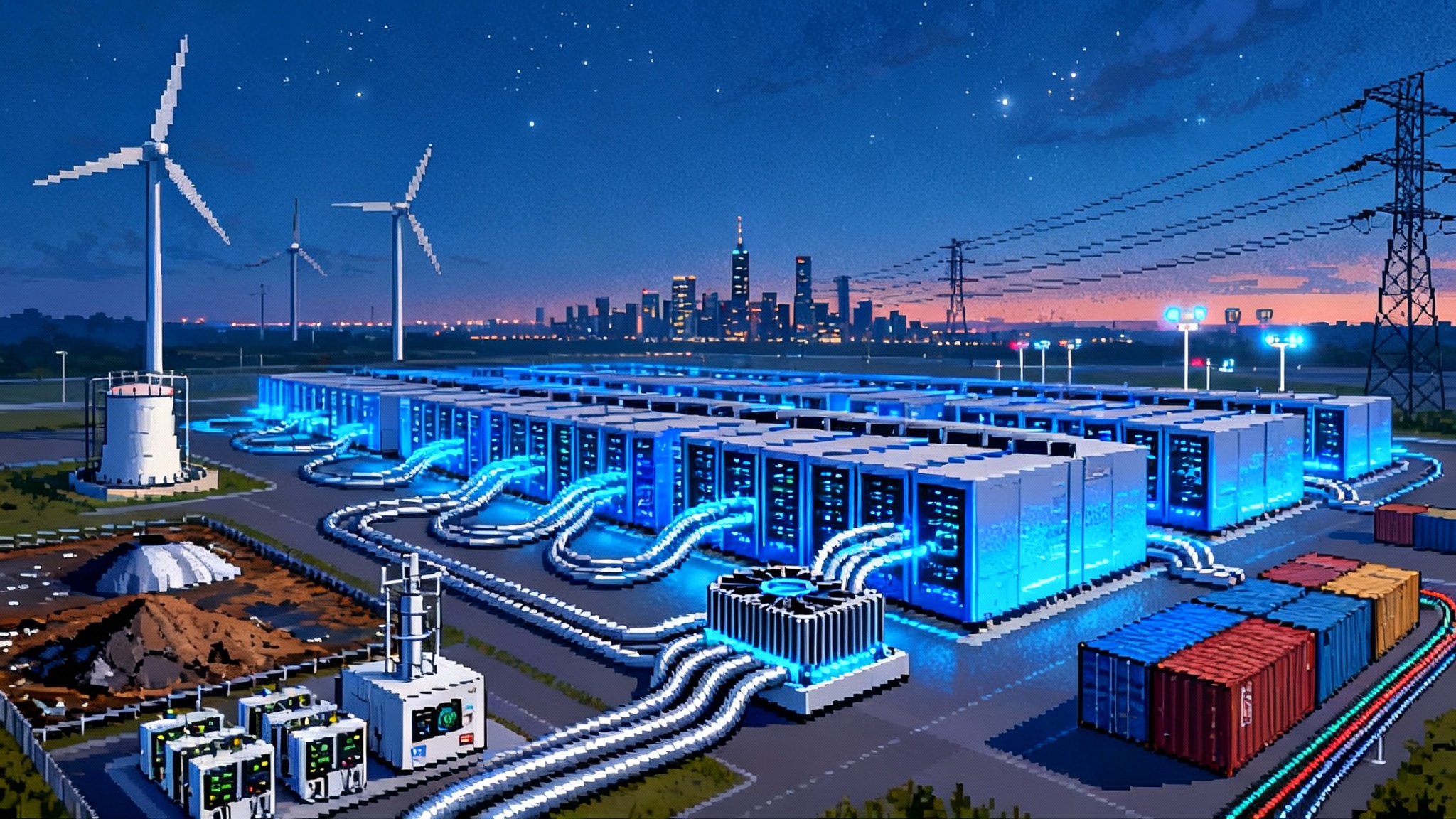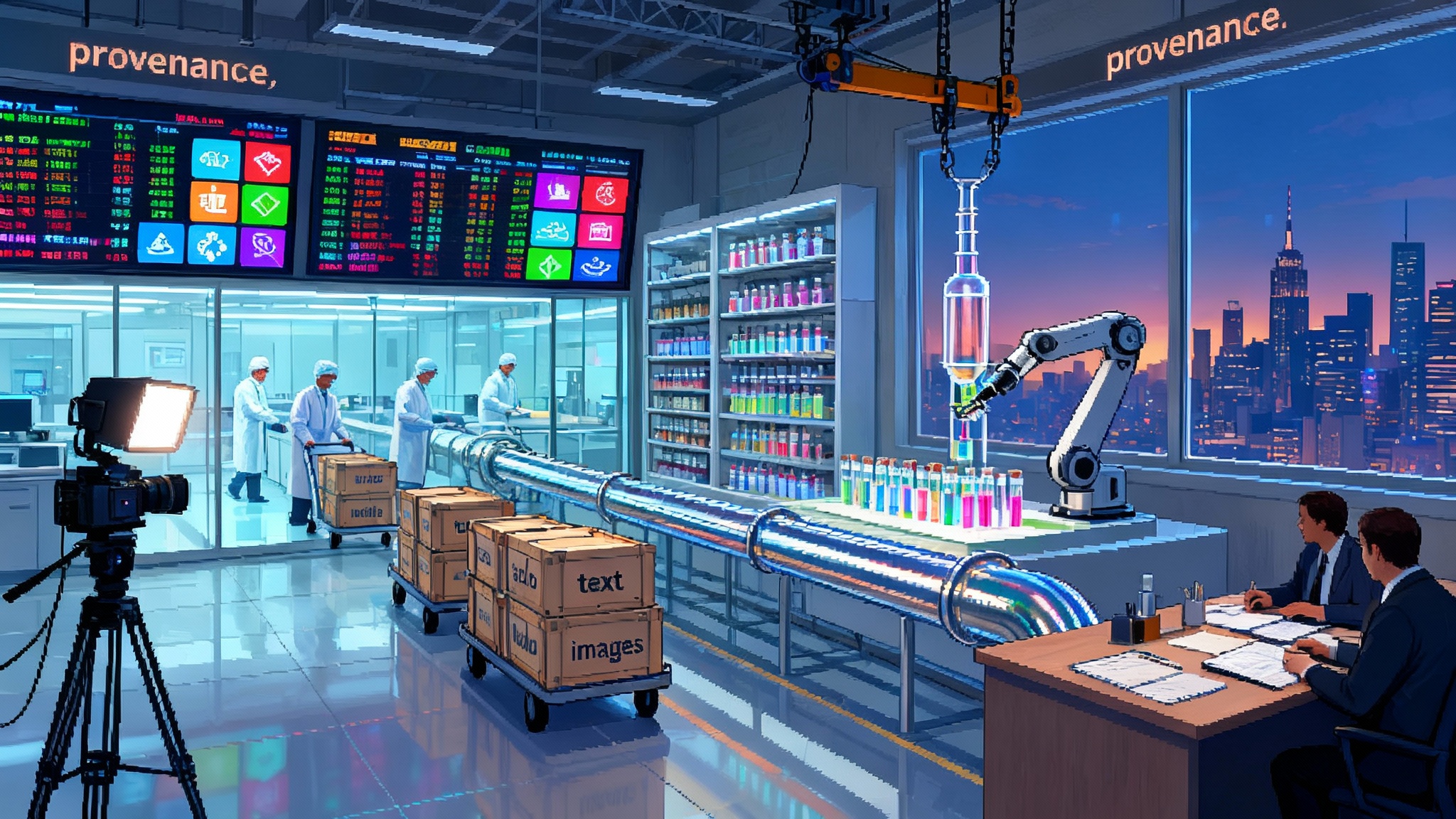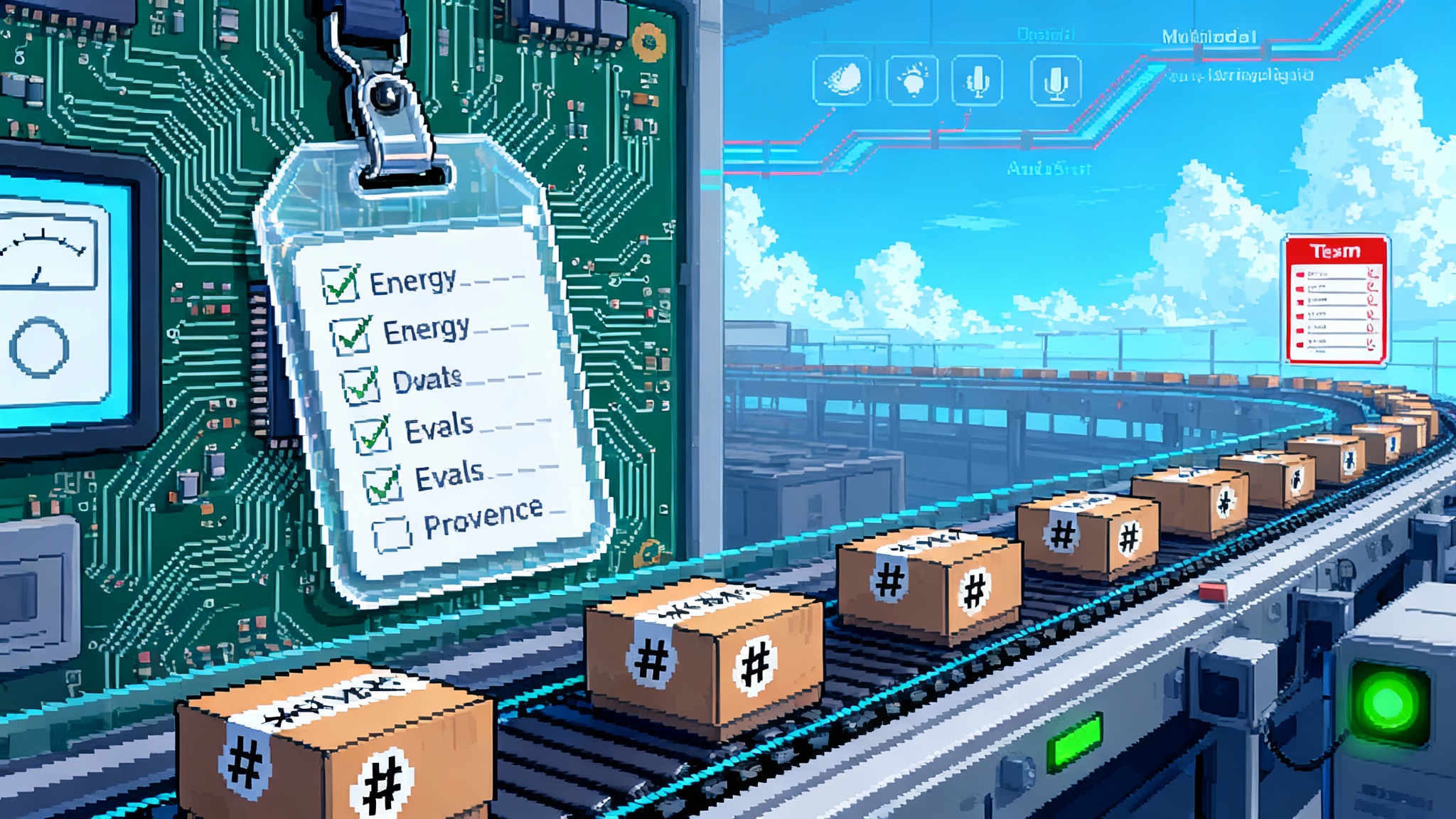The Grid Is the New GPU: AI’s Race Hits a Power Wall
This week’s burst of hyperscaler power deals and fresh local permitting fights made one thing plain: AI’s bottleneck has shifted from chips to kilowatts. Here is the new playbook for power, siting, latency, and cost over the next year.

Breaking: The Grid Is the New GPU
This week delivered another round of megawatt headlines. Hyperscalers announced gigawatt-scale purchases of firm power across multiple regions, while county boards from Virginia to Oregon tabled or tightened permits for new data centers. The message is clear. The AI race is no longer constrained by who can source the newest accelerator. It is constrained by who can source electricity that is available, affordable, and buildable where fiber goes. The grid is the new GPU.
If that sounds dramatic, consider a training cluster with 50,000 high-end accelerators. At 700 watts per device before cooling and networking, that cluster easily crosses 35 megawatts at the plug. With a realistic power usage effectiveness, the site draws closer to 45 megawatts. That is the load of a mid-size town, for months. Repeat this for every major model and every refresh cycle, and the bottleneck shifts from wafer supply to wires, permits, and substations.
From chip scarcity to kilowatt scarcity
Last year’s question was how many accelerators you could get, at what price, and whether your interconnect could keep them busy. This year’s question is how many megawatts you can secure, when they will arrive, and whether the community will let you build them.
The choke points moved:
- Interconnection queues: Getting a new grid connection of tens of megawatts in many U.S. regions is now a three to seven year process. PJM and MISO have multi-year backlogs. In fast-build markets like ERCOT you can move quicker, but you still face transmission congestion and price spikes.
- Permitting: Local resistance focuses on noise, visual impact, water use, and diesel backup. Counties that once waved projects through now ask for buffers, quiet hours, and water-free cooling.
- Firm power: Renewable projects are abundant on paper, but deliverability at your node and during your duty cycle is scarce. Hedging congestion and shape risk matters as much as headline megawatts.
Meanwhile, compute demand keeps rising. Inference is no longer a rounding error. It runs all day, not just during a training cycle, and it wants predictable latency. The grid did not grow for that. So the leaders are assembling a new stack that blends power procurement, onsite generation, flexible operations, and power-aware software.
The new playbook: five moves you will see next
1) Long-term power purchase agreements that actually match load
The first instinct is to buy lots of renewable energy certificates and call it a day. That is not enough. The next wave of deals is longer, more specific, and closer to the data center’s actual power shape.
- Duration and firmness: Expect 10 to 20 year agreements with firm blocks in peak hours, not just annual megawatt-hours. Several hyperscalers already announced multi-gigawatt portfolios with detailed delivery windows.
- 24/7 matching: Instead of offsetting with annual averages, buyers want hourly matching by region. That usually means blending wind, solar, storage, and some form of firm low-carbon supply like hydro or nuclear.
- Locational reality: It matters whether your power shows up at your node. Congestion can erase the green claim and the hedge. Sophisticated buyers negotiate nodal settlement or locate near the generation they buy.
- Storage as a shaper: Four to eight hour batteries are becoming standard parts of PPAs to turn intermittent megawatt-hours into a usable power profile. Buyers pay for the shape, not just the energy.
Practical takeaway: If you run a fast-growing AI service, hire an energy lead who speaks nodal markets and congestion risk. Your real question is not “how many megawatt-hours” but “what hourly shape, at which node, with what rights to curtailment, and what happens if the substation upgrade slips a year.”
2) Small modular reactor pilots to anchor large campuses
Nuclear has reentered the data center conversation for a simple reason: it is firm, low-carbon, and compact. The timelines are long and the technology pathways vary. But pilots are getting scoped around future campuses and retired industrial sites with existing transmission.
- Technology menu: Designs range from light-water units like the BWRX-300 to microreactors. Each has different licensing paths and timelines.
- Siting advantage: Co-locating near existing nuclear or former coal sites taps existing transmission and skilled labor. It also meets communities already familiar with energy infrastructure.
- Realistic horizon: Most meaningful nuclear capacity for data centers arrives late in the decade, not next summer. Pilots now are about site control, public engagement, and learning the licensing process.
Practical takeaway: If you have a ten-year campus plan, reserve land at or near a transmission-rich brownfield and start the community process now. Pair it with nearer-term PPAs and storage so you have a bridge to that future.
3) Methane-to-megawatt microgrids to fill the gap fast
Landfill gas, agricultural digesters, and stranded gas at oil fields leak methane today. Turning that into electricity cuts greenhouse gas impact and creates local power. Bitcoin miners proved the field deployment model. AI operators are next in line.
- Speed and scale: A single landfill can host several megawatts of engines within a year. Multiple sites can be federated into a private network for training bursts, non-latency-critical inference, or preprocessing.
- Carbon math: Captured methane burned for power can reduce net warming compared to venting or flaring. The impact hinges on capture efficiency and leakage control.
- Connectivity challenge: You need fiber, or you need to bring data to the power with physical media. That favors workloads that can tolerate high-latency bulk transfer.
Practical takeaway: Build a portfolio of five to ten small sites within driving distance of a fiber backbone. Use them as a flexible training tier, not as your primary low-latency inference edge. Contract with operators who already run compliant landfill gas or flare-gas projects.
4) Demand-response inference earns you megawatts and social license
In many markets the grid will pay you to reduce load during tight periods. Historically data centers hated curtailment. AI flips that assumption. If you architect your inference to degrade gracefully for an hour, you gain revenue and goodwill.
- Product tiers: Offer a low-latency premium tier that stays on, and a standard tier that can shift or slow during grid events. Communicate windows in advance when possible.
- Model lineup: Keep a small, efficient model warmed and ready. During a curtailment signal, route most requests to it and reserve the larger model for users who pay for it.
- Utility integration: Register as a controllable load resource in markets that allow it. Work with your utility on telemetry and response times. You can earn demand response payments while reducing your interconnection hurdles.
Practical takeaway: Put curtailment into your service level agreements. Not as a loophole, but as a feature with clear behavior. It makes permitting conversations easier and cuts your effective power cost.
5) Power-aware model and runtime design
The fastest way to get more compute out of the same megawatt is to make the model and runtime smarter about power.
- Quantization and sparsity: Four-bit weights for inference, dynamic sparsity in attention, and mixture-of-experts routing reduce energy per token. Design the gating to route most requests to small experts and reserve heavy experts for complex prompts.
- Speculative decoding and caching: Use a small model to draft tokens and confirm with a larger one. Cache retrieval results and KV states across sessions where privacy allows.
- Power caps and scheduling: Coordinate the cluster scheduler with power capping at the rack level. When the grid is tight, keep latency by shedding background jobs and reducing batch sizes before you drop clocks.
- Energy as a first-class metric: Report joules per thousand tokens next to latency. Track it per model and per region. Engineers improve what they can see.
Practical takeaway: Open a new performance objective for energy per token and make it part of every model launch. The curve will bend faster than you expect, and it converts directly into more available capacity without more megawatts.
Startup siting in the power era
If you are a startup choosing a first serious site, the map has changed. The best location is not simply where fiber is cheap and land is zoned industrial. It is where you can get power you control, on a timeline that matches your roadmap.
A practical checklist for the next 12 months:
- Choose a grid you can read: ERCOT in Texas offers speed, transparent prices, and demand response options. PJM offers firm power and proximity to East Coast users, but queues are long. The Northwest has hydro and cool climate, but permitting has tightened around water and visibility.
- Go behind the meter if you can: Buying an existing small peaker plant or co-locating at an industrial site with spare interconnection capacity is faster than a new interconnect. It also gives you leverage in utility conversations.
- Water and noise: Air-cooled designs with heat reuse reduce local opposition. Offer to heat a nearby campus or greenhouse. Design for quiet nights. These are not luxuries, they are your permit.
- Fiber first, but not fiber only: Build two diverse fiber routes. Budget time for municipal work windows. If you plan to federate micro-sites, verify dark fiber availability before you sign a land deal.
- Permitting diplomacy: Meet the planning board before you file. Bring a clear demand-response plan and an emergency generator plan that minimizes diesel. Offer community benefits tied to measurable outcomes like tax base and workforce training.
For teams that cannot or should not build their own power, choose colocation partners with real interconnection rights, not just marketing decks. Ask for the substation name, the queue position, and the expected in-service date. Verify with the utility that the capacity is real.
Latency service levels meet grid reality
Latency is a physical fact. Power is a political and physical fact. The trick is to partition your service so each respects the other.
- Tiered inference: Put small models in every metro you care about for sub-50 millisecond responses. Place large models in a few regional hubs with deep power and fiber. Route queries based on estimated complexity and user tier.
- Anycast plus policy: Use anycast to bring users to the nearest edge, but add policies that prefer edges with available power headroom. Keep a live map of megawatt margin by region and feed it into routing decisions.
- Local caching: Cache embeddings, retrieval corpora, and common tool calls at the edge. Only the uncached heavy lifts travel to the regional hubs.
- Onsite storage for resilience: Add four to eight hours of battery at key inference edges. That covers most grid events without resorting to generators, and it simplifies your promise to customers.
The result is a graceful service. When the grid gets tight in one region, your system routes around it. Users see consistent behavior, and you keep earning.
Cost curves for the next 12 months
Electricity will dominate operating cost as models get cheaper to buy and more expensive to run at scale. Here is how to think about the next year.
- Electricity price risk: Spot markets are volatile during heat waves and cold snaps. Long-term PPAs with shaped delivery reduce that volatility. Expect more buyers to pay premiums for firm peak blocks.
- Energy share of total cost: For large training runs, energy is already a double-digit percentage of total cost. A 50 megawatt cluster running for 90 days consumes about 108 gigawatt-hours. At 50 dollars per megawatt-hour, that is 5.4 million dollars before cooling and losses. At 100 dollars per megawatt-hour it doubles.
- Inference at scale: Per-token energy is small, but not trivial at the scale of billions of tokens a day. Improving energy per thousand tokens by 20 percent can save millions annually and frees capacity in constrained regions.
- Capacity is a cost: The real cost curve now includes the value of a megawatt-month. If you can avoid adding a substation by being 15 percent more efficient, that efficiency has capital value, not just a lower bill.
Expect two broad patterns this year:
- Companies that pre-commit to firm power and storage post flatter cost curves and fewer outages. They spend more upfront, and they win market share during tight periods because they stay online.
- Companies that run on spot power only face higher volatility and more service degradation. Some will compensate with excellent power-aware software and flexible SLAs. A few will pay more in diesel and goodwill than they save in capital.
What it means for policy and operators
Policy is catching up. Utilities and grid operators want flexible loads that help, not hurt. AI can be that.
- Interconnection reform: Queue reform is underway to clear backlogs. Engage early. Project readiness screens are real and favor teams with land rights, permits, and credible equipment plans.
- Tariffs for flexible compute: Ask for tariffs that reward fast demand response and low minimum takes. Share your telemetry. In return, ask for clearer curtailment rules and faster service upgrades.
- Environmental balance: Water use and diesel are flashpoints. Favor dry cooling. Replace diesel with natural gas or battery where feasible. Publish your hourly carbon intensity by region. It lowers political friction and helps you steer load.
Communities have a choice: let data centers arrive randomly, or shape how they plug in so they strengthen local grids. Operators that show up as partners get permits. Those that do not get hearings and delays.
The bottom line
Chips still matter. Networking still matters. But the scarce input for AI in the next year is megawatts delivered to the right place, on the right schedule, with a shape your models can use. The leaders are no longer just ordering accelerators. They are negotiating firm blocks of power, stacking storage, piloting small modular reactors, wiring microgrids on methane that would have leaked, and teaching their models to respect the grid.
There is a simple way to think about it. Treat power like a first-class part of your architecture. Add a power layer to your roadmap, your product, and your culture. Instead of asking “how many GPUs can we get,” ask “how many good megawatts can we command, and how do we squeeze more intelligence out of each one.” The teams that learn to do that will find the next unlocked level of scale. The grid is the new GPU. Operate accordingly.



